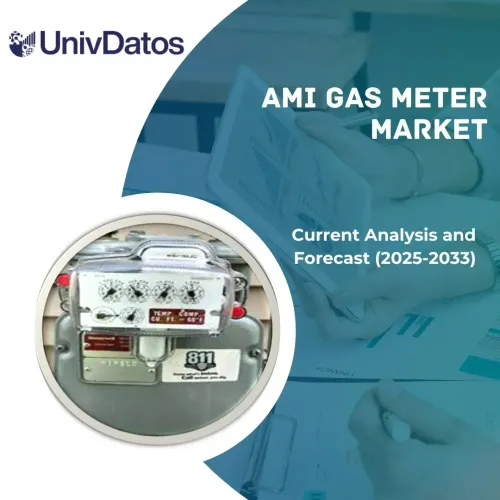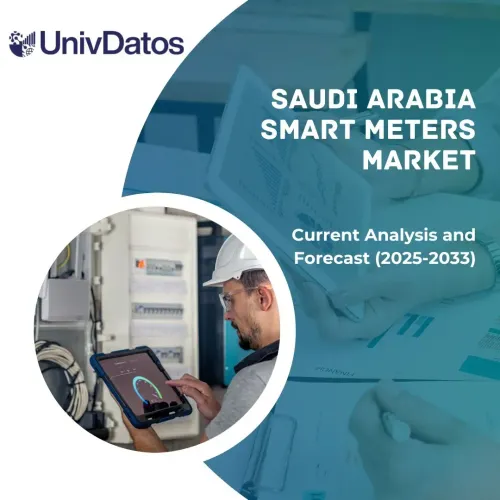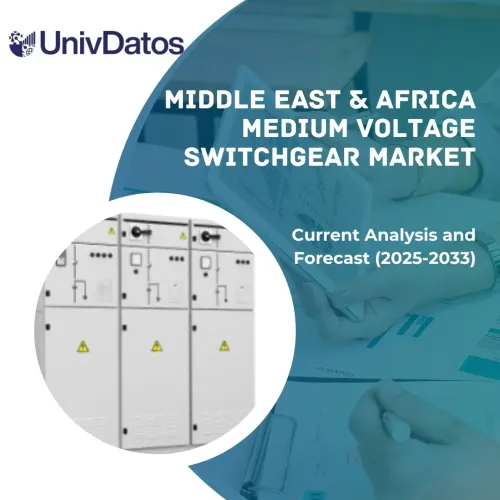- Home
- About Us
- Industry
- Services
- Reading
- Contact Us
Wind Energy Market: Current Analysis and Forecast (2024-2032)
Emphasis on Component (Turbine, Support Structure, Electrical Infrastructure, and Others); Application (Onshore and Offshore); Region/Country

Wind Energy Market Size & Forecast
The Wind Energy Market was valued at approximately USD 90 billion in 2023 and is expected to grow at a substantial CAGR of around 9.4% during the forecast period (2024-2032) owing to the growing awareness of climate change.
Wind Energy Market Analysis
Wind power is among the categories of renewable energy that utilize the power of winds and convert it into electrical energy. Wind, in turn, enables the conversion of kinetic energy to mechanical power and their further conversion to electrical energy within a wind turbine in the form of a generator. Wind energy does not emit any direct gases, and it has been enjoying increased use in the world due to the expansive benefits of ecological and economic natures.
As the wind energy industry strives to achieve more growth, several strategies are being applied, among them are offshore wind farms as well as repowering of existing wind farms for higher capacity, and the integration of advanced technologies like maintenance by use of AI among others. For instance, on 7 August 2024. The Nordex Group received two orders from France for a total of 57 MW. The orders also include the Premium Service for the maintenance of the turbines over 20 years after commissioning in autumn 2025. In Centre-Val-de-Loire four N149/5.X turbines are being installed on 105-metre-high tubular steel towers in a 22.8 MW wind farm. They are also utilizing government incentives and are extending the use of hybrid power solutions incorporating wind and solar along with storage for volatile power.
Wind Energy Market Trends
This section discusses the key market trends influencing the various segments of the Wind Energy market as identified by our research experts.
Onshore Segment Transforms Wind Energy Industry
The onshore wind energy segment held a dominant share of the wind energy market, as indicated by the lower cost of installation and operations against the risks involved in offshore wind energy projects. Onshore wind farms are easier to install since they do not demand elaborate hardware and can instantly adapt to enhanced energy requirements. Also, the onshore wind location spots are predominantly in areas with large land and good wind regimes for the generation of electricity. For instance, on 16 September 2024, BP announced that it plans to sell its existing US onshore wind energy business, bp Wind Energy, and aims to bring together the development of onshore renewable power projects through Lightsource bp. Moreover, advances in the technology of the turbine and its compatibility with the grid have only added to the viability of onshore wind power. These, coupled with government support and policies in many regions, have ensured that the onshore wind takes the largest share in the global wind energy market and drives its growth. For instance, on January 29, 2024, GE Vernova’s Onshore Wind business confirmed the signing of a strategic framework agreement with Squadron Energy for 1.4 gigawatts (GW) of onshore wind projects in New South Wales, Australia. The agreement was initially announced by Squadron Energy earlier this month to mark the start of construction of the Uungala Wind Farm.

Asia-Pacific leads the market.
The Asia-Pacific holds a significant share of the global wind energy market, backed by government support, increased industrialization, and an escalating focus on cleaner energy solutions to combat pollution and climate change. China, the world’s largest wind energy market, has focused on onshore wind and offshore wind investment, while India is increasing its wind energy capacity as a path to energy transition. As per the Global Wind Energy Council report 2024, China led the world in annual offshore wind development for the sixth year in a row with 6.3 GW commissioned in 2023, making up 58% of global additions and bringing its total offshore wind installations to 38 GW, 3.7 GW (11%) higher than Europe. Elsewhere in the APAC region, three markets commissioned new offshore wind capacity last year: Taiwan (China) (692 MW), Japan (62 MW) and South Korea (4 MW). In the same regard, increased innovation in the design of wind turbines and the reduced cost of the energy source have made the use of wind energy cheaper than other known conventional sources of energy. Such regional development is further supported by large-scale infrastructure investment and cross-border collaboration that place Asia-Pacific at the forefront of global wind energy development.
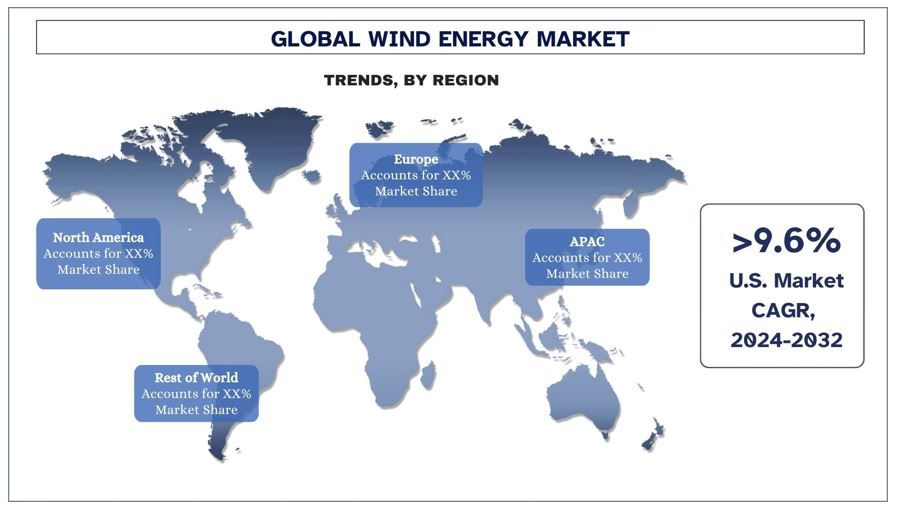
Wind Energy Industry Overview
The Wind Energy market is competitive, with several global and international players. The key players are adopting different growth strategies to enhance their market presence, such as partnerships, agreements, collaborations, new product launches, geographical expansions, and mergers and acquisitions. Some of the major players operating in the market are Nordex SE, Suzlon Energy Limited, Ørsted A/S, GE Vernova, ABB, Vestas, Siemens Gamesa Renewable Energy, S.A.U., Goldwind Science&Technology Co., Ltd., Envision Group, ENERCON Global GmbH.
Wind Energy Market News
- On September 9, 2024, Suzlon Group, India’s largest renewable energy solutions provider, announced bagging India’s largest wind energy order from NTPC Green Energy Limited (the renewables arm of India’s largest energy conglomerate NTPC Limited) for 1166 MW.
- On January 25, 2024, Ørsted signed an agreement with Eversource to acquire Eversource’s 50% share of Sunrise Wind, a 924 MW offshore wind farm that would deliver power to New York. The acquisition is subject to the successful award of Sunrise Wind in the ongoing New York 4 solicitation for offshore wind capacity, signing of an OREC (Offshore Wind Renewable Energy Certificates) contract with New York’s energy agency, NYSERDA, entry into long-form acquisition agreements, receipt of construction and operations plan (COP), and relevant regulatory approvals.
- On December 14, 2023,GE Vernova announced that it has signed a framework agreement with Forestalia to install up to 693 MW of onshore wind turbines across 16 future project sites throughout the Aragon region in Spain.
Wind Energy Market Report Coverage
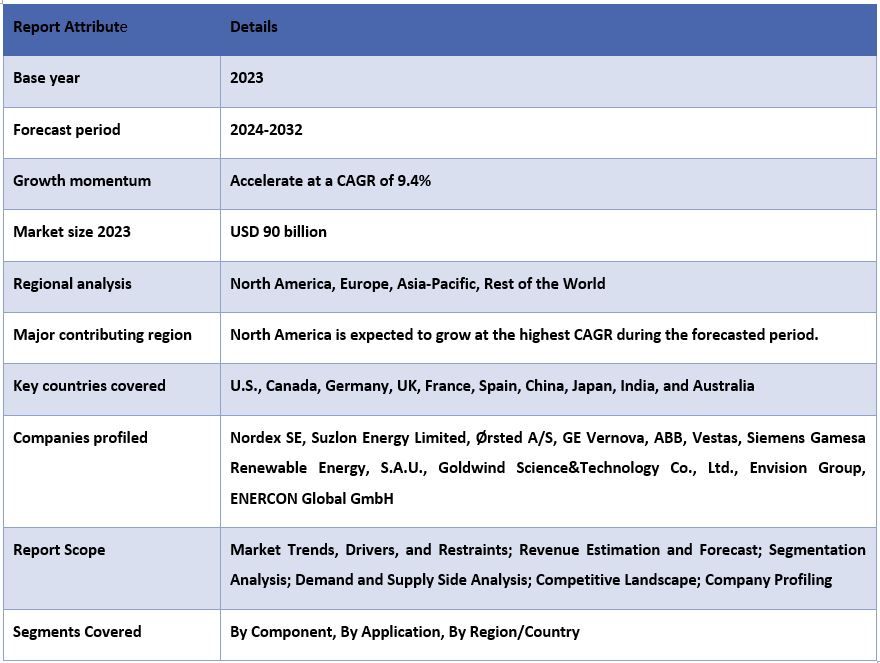
Reasons to buy this report:
- The study includes market sizing and forecasting analysis validated by authenticated key industry experts.
- The report presents a quick review of overall industry performance at one glance.
- The report covers an in-depth analysis of prominent industry peers with a primary focus on key business financials, product portfolios, expansion strategies, and recent developments.
- Detailed examination of drivers, restraints, key trends, and opportunities prevailing in the industry.
- The study comprehensively covers the market across different segments.
- Deep dive regional level analysis of the industry.
Customization Options:
The global Wind Energy market can be customized further as per the requirement or any other market segment. Besides this, UMI understands that you may have your own business needs, hence feel free to connect with us to get a report that completely suits your requirements.
Table of Content
Research Methodology for the Wind Energy Market Analysis (2022-2032)
Analyzing the historical market, estimating the current market, and forecasting the future market of the global Wind Energy market were the three major steps undertaken to create and analyze the adoption of Wind Energy in major regions globally. Exhaustive secondary research was conducted to collect the historical market numbers and estimate the current market size. Secondly, to validate these insights, numerous findings and assumptions were taken into consideration. Moreover, exhaustive primary interviews were also conducted, with industry experts across the value chain of the global Wind Energy market. Post assumption and validation of market numbers through primary interviews, we employed a top-down/bottom-up approach to forecasting the complete market size. Thereafter, market breakdown and data triangulation methods were adopted to estimate and analyze the market size of segments and sub-segments of the industry. Detailed methodology is explained below:
Analysis of Historical Market Size
Step 1: In-Depth Study of Secondary Sources:
A detailed secondary study was conducted to obtain the historical market size of the Wind Energy market through company internal sources such as annual reports & financial statements, performance presentations, press releases, etc., and external sources including journals, news & articles, government publications, competitor publications, sector reports, third-party database, and other credible publications.
Step 2: Market Segmentation:
After obtaining the historical market size of the Wind Energy market, we conducted a detailed secondary analysis to gather historical market insights and share for different segments & sub-segments for major regions. Major segments are included in the report as component, application, and regions. Further country-level analyses were conducted to evaluate the overall adoption of testing models in that region.
Step 3: Factor Analysis:
After acquiring the historical market size of different segments and sub-segments, we conducted a detailed factor analysis to estimate the current market size of the Wind Energy market. Further, we conducted factor analysis using dependent and independent variables such as component, application, and regions of the Wind Energy market. A thorough analysis was conducted for demand and supply-side scenarios considering top partnerships, mergers and acquisitions, business expansion, and product launches in the Wind Energy market sector across the globe.
Current Market Size Estimate & Forecast
Current Market Sizing: Based on actionable insights from the above 3 steps, we arrived at the current market size, key players in the global Wind Energy market, and market shares of the segments. All the required percentage shares split and market breakdowns were determined using the above-mentioned secondary approach and were verified through primary interviews.
Estimation & Forecasting: For market estimation and forecast, weights were assigned to different factors including drivers & trends, restraints, and opportunities available for the stakeholders. After analyzing these factors, relevant forecasting techniques i.e., the top-down/bottom-up approach were applied to arrive at the market forecast for 2032 for different segments and sub-segments across the major markets globally. The research methodology adopted to estimate the market size encompasses:
- The industry’s market size, in terms of revenue (USD) and the adoption rate of the Wind Energy market across the major markets domestically
- All percentage shares, splits, and breakdowns of market segments and sub-segments
- Key players in the global Wind Energy market in terms of products offered. Also, the growth strategies adopted by these players to compete in the fast-growing market
Market Size and Share Validation
Primary Research: In-depth interviews were conducted with the Key Opinion Leaders (KOLs) including Top Level Executives (CXO/VPs, Sales Head, Marketing Head, Operational Head, Regional Head, Country Head, etc.) across major regions. Primary research findings were then summarized, and statistical analysis was performed to prove the stated hypothesis. Inputs from primary research were consolidated with secondary findings, hence turning information into actionable insights.
Split of Primary Participants in Different Regions
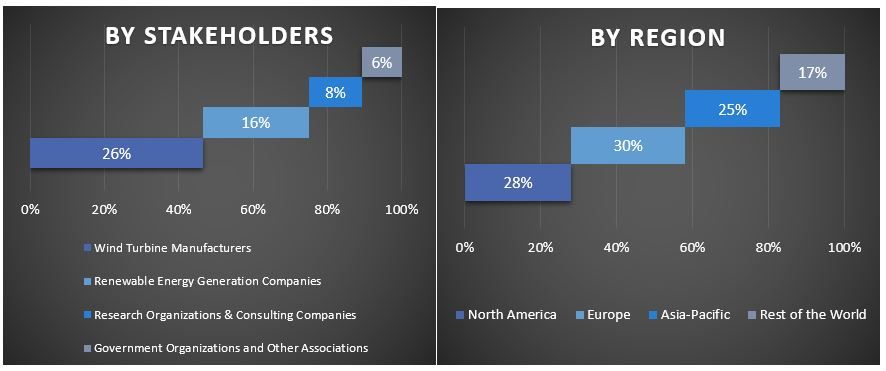
Market Engineering
The data triangulation technique was employed to complete the overall market estimation and to arrive at precise statistical numbers for each segment and sub-segment of the global Wind Energy market. Data was split into several segments and sub-segments after studying various parameters and trends in the component, application, and regions of the global wind energy market.
The main objective of the Global Wind Energy Market Study
The current & future market trends of the global Wind Energy market were pinpointed in the study. Investors can gain strategic insights to base their discretion for investments on the qualitative and quantitative analysis performed in the study. Current and future market trends determined the overall attractiveness of the market at a regional level, providing a platform for the industrial participant to exploit the untapped market to benefit from a first-mover advantage. Other quantitative goals of the studies include:
- Analyze the current and forecast market size of the Wind Energy market in terms of value (USD). Also, analyze the current and forecast market size of different segments and sub-segments.
- Segments in the study include areas of the component, application, and regions.
- Define and analyze the regulatory framework for the Wind Energy
- Analyze the value chain involved with the presence of various intermediaries, along with analyzing customer and competitor behaviors of the industry.
- Analyze the current and forecast market size of the Wind Energy market for the major region.
- Major countries of regions studied in the report include Asia Pacific, Europe, North America, and the Rest of the World
- Company profiles of the Wind Energy market and the growth strategies adopted by the market players to sustain the fast-growing market.
- Deep dive regional level analysis of the industry
Frequently Asked Questions FAQs
Q1: What is the Wind Energy market's current size and growth potential?
Q2: What are the driving factors for the growth of the Wind Energy market?
Q3: Which segment has the largest share of the Wind Energy market by application?
Q4: What are the major trends in the Wind Energy market?
Q5: Which region will dominate the Wind Energy market?
Related Reports
Customers who bought this item also bought

